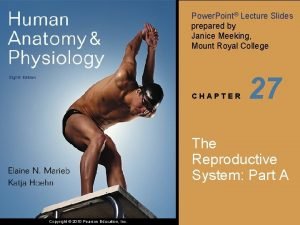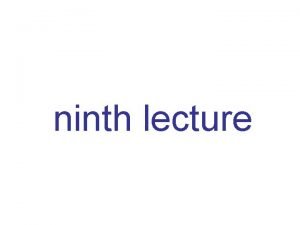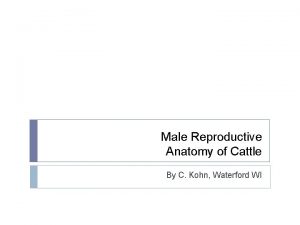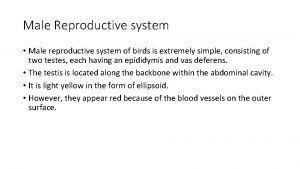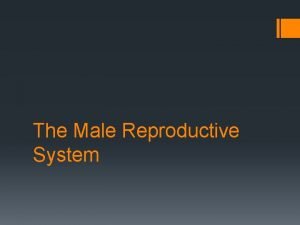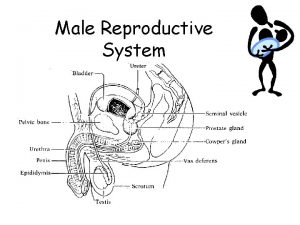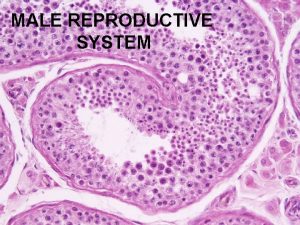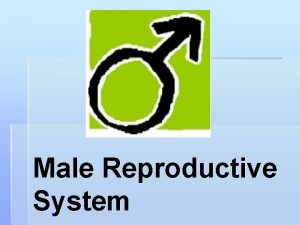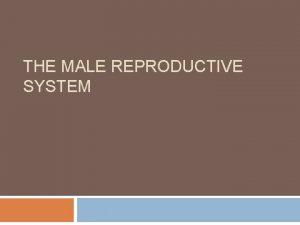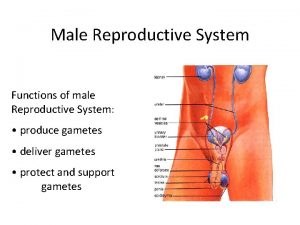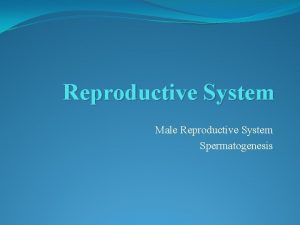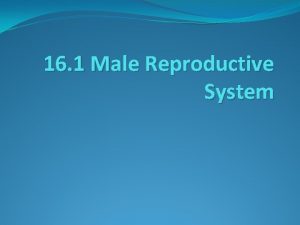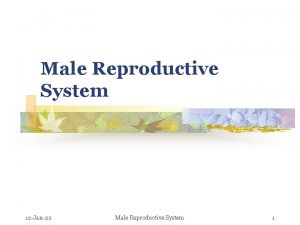REPRODUCTIVE SYSTEM Class Notes Male Reproductive System The




















- Slides: 20

REPRODUCTIVE SYSTEM Class Notes

Male Reproductive System • The main functions of the Male Reproductive System include: • 1) Produce, maintain and transport sperm. • 2) Produce and secrete male sex hormones.

Male Reproductive System • Parts of the Male Reproductive System include: • 1) Penis • 2) Scrotum • 3) Testicles • 4) Epididymis • 5) Vas Deferens • 6) Prostate Gland • 7) Urethra

Penis • The penis is the male organ used in sexual intercourse.

Scrotum • The scrotum are sacs that contain the testes.

Testicles • Located inside the scrotum and make testosterone as well as generate sperm.

Epididymis • The epididymis is a tube located on each testicle that transports sperm and brings them to maturity.

Vas Deferens • Vas Deferens are long muscular tubes that travel from the epididymis to the pelvic cavity. They send mature sperm through the urethra.

Urethra • The urethra transport both urine and sperm.

Prostate Gland • The prostate gland produces fluids that nourish the sperm.

Female Reproductive System • The functions of the female reproductive system include: • 1) produce egg cells necessary for reproduction, called ova or oocytes. • 2) to house, nourish and birth offspring.

Female Reproductive System • Parts of the Female Reproductive System include: • 1) Ovaries • 2) Fallopian Tubes • 3) Uterus • 4) Cervix • 5) Vagina

Vagina • The vagina is a canal that joins the cervix to the outside of the body. It is known as the birthing canal.

Uterus • The uterus is also called the womb. • It consists of two parts the cervix and the corpus. • The corpus is the upper part of the uterus and it is where the baby is developed. It expands as the baby grows. • The cervix is the lower part of the uterus and it opens into the vagina. It is a channel for sperm and menstrual blood as well.

Ovaries • Ovaries are located on either side of the uterus and produce eggs and hormones.

Fallopian Tubes • Fallopian Tubes are tunnels to travel from the ovaries to the uterus.

Conception • Conception is the fertilization of an egg by a sperm. • The egg then implants into the uterus wall to begin the initial stages of pregnancy. • Conception usually occurs in the Fallopian Tubes. • If fertilization does not occur, then menstruation takes place. Menstruation is when the body removes the unfertilized uterus wall.

Fertilization to Birth • Day 1 – Fertilization; all human chromosomes present. • Day 6 – Embryo begins implantation into the uterus. • Day 22 – Heart is able to be detected. • Week 3 – Spinal Cord and Nervous System starts to form as well as the liver, kidneys and intestines. • Week 4 – The baby is 10, 000 times larger than at fertilization. • Week 5 – Eyes, legs and hands begin to develop. • Week 6 – Brain waves are detectable. Mouth and lips are present.

Fertilization to Birth • Week 7 – The baby is kicking and swimming. • Week 8 – The bones begin to form and the baby can hear. • Week 9 and 10 – The baby can grasp objects. All organ systems are functioning. Baby can hiccup and teeth form. • Weeks 11 through 14 – Vocal cords are complete. The baby can suck its thumb. The heart pumps several quarts of blood everyday. • Month 4 – Bone marrow forms. The baby is 8 – 10 inches long and weighs ½ a pound. The baby can dream.

Fertilization to Birth • Month 5 and 6 – Lungs continue to develop. Mom can now feel baby kicking, moving and hiccupping. The baby is 12 inches long. • Months 7 through 9 – Immune system develops. All systems continue to develop preparing for delivery. • Approximately 1 week before birth the baby stops growing and drops usually head down into the pelvic cavity.
 Function of vagina
Function of vagina Male reproductive system and its function
Male reproductive system and its function Male and female reproductive system
Male and female reproductive system Exercise 42 anatomy of the reproductive system
Exercise 42 anatomy of the reproductive system Uterus layers histology
Uterus layers histology Female sex organ diagram
Female sex organ diagram Male fallopian tube
Male fallopian tube The reproductive system chapter 16
The reproductive system chapter 16 Luteinizing hormone in male reproductive system
Luteinizing hormone in male reproductive system Male reproductive system in plants
Male reproductive system in plants Art-labeling activity: the male reproductive system, part 1
Art-labeling activity: the male reproductive system, part 1 Male reproductive system information
Male reproductive system information Where semen stored
Where semen stored Bull reproductive system parts and functions
Bull reproductive system parts and functions Prostate glan
Prostate glan Asexual reproduction
Asexual reproduction Disease traductor
Disease traductor Cartilaginous fish reproduction
Cartilaginous fish reproduction In pila fertilization is
In pila fertilization is Fetal pig female reproductive system
Fetal pig female reproductive system Male plant reproductive system
Male plant reproductive system










